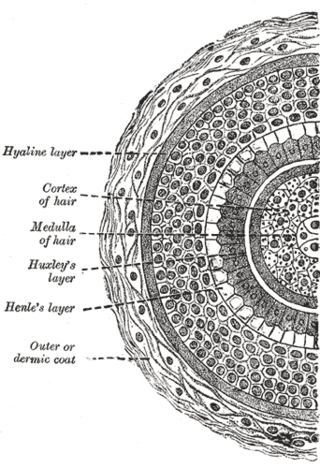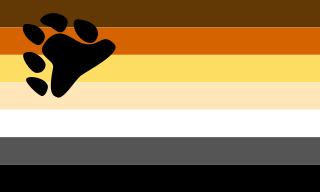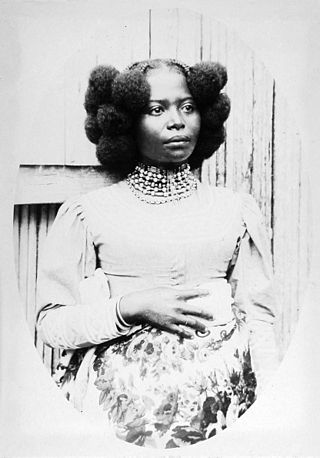Related Research Articles

Hair is a protein filament that grows from follicles found in the dermis. Hair is one of the defining characteristics of mammals. The human body, apart from areas of glabrous skin, is covered in follicles which produce thick terminal and fine vellus hair. Most common interest in hair is focused on hair growth, hair types, and hair care, but hair is also an important biomaterial primarily composed of protein, notably alpha-keratin.

Lambda is the eleventh letter of the Greek alphabet, representing the voiced alveolar lateral approximant IPA:[l]. In the system of Greek numerals, lambda has a value of 30. Lambda is derived from the Phoenician Lamed. Lambda gave rise to the Latin L and the Cyrillic El (Л). The ancient grammarians and dramatists give evidence to the pronunciation as (λάβδα) in Classical Greek times. In Modern Greek, the name of the letter, Λάμδα, is pronounced.
A signature block is a personalized block of text automatically appended at the bottom of an email message, Usenet article, or forum post.
In computer science, Backus–Naur form is a notation used to describe the syntax of programming languages or other formal languages. It was developed by John Backus and Peter Naur. BNF can be described as a metasyntax notation for context-free grammars. Backus–Naur form is applied wherever exact descriptions of languages are needed, such as in official language specifications, in manuals, and in textbooks on programming language theory. BNF can be used to describe document formats, instruction sets, and communication protocols.

The handkerchief code is a system of color-coded cloth handkerchief or bandanas for non-verbally communicating one's interests in sexual activities and fetishes. The color of the handkerchief identifies a particular activity, and the pocket it is worn in identifies the wearer's preferred role in that activity. Wearing a handkerchief on the left side of the body typically indicates one is a "top" while wearing it on the right side of the body would indicate one is a "bottom". For example, a dark blue handkerchief indicates an interest in anal sex, and wearing it in the left pocket indicates a preference for being the penetrating partner. The code was first used in the 1970s in the United States, Canada, Australia, and Europe, by gay and bisexual men seeking casual sex or BDSM practitioners. Over time the colors and types of apparel in use have greatly proliferated.

In gay culture, bear is a term for men who are large, hairy, or both.

The Geek Code, developed in 1993, is a series of letters and symbols used by self-described "geeks" to inform fellow geeks about their personality, appearance, interests, skills, and opinions. The idea is that everything that makes a geek individual can be encoded in a compact format which only other geeks can read. This is deemed to be efficient in some sufficiently geeky manner.
The tilde˜ or ~, is a grapheme with a number of uses. The name of the character came into English from Spanish, which in turn came from the Latin titulus, meaning 'title' or 'superscription'. Its primary use is as a diacritic (accent) in combination with a base letter; but, for historical reasons, it is also used in standalone form within a variety of contexts.

Harvey Forbes Fierstein is an American actor, playwright, and screenwriter, known for his distinctive gravelly voice. He is best known for his theater work in Torch Song Trilogy and Hairspray and film roles in Mrs. Doubtfire, Independence Day, and as the voice of Yao in Mulan and Mulan II. Fierstein won two Tony Awards, Best Actor in a Play and Best Play, for Torch Song Trilogy. He received his third Tony Award, Best Book of a Musical, for the musical La Cage aux Folles and his fourth, the Tony Award for Best Actor in a Musical, for playing Edna Turnblad in Hairspray, a role he revived in its live television event, Hairspray Live! Fierstein also wrote the books for the Tony Award-winning musicals Kinky Boots, Newsies, and Tony Award-nominated, Drama League Award-winner A Catered Affair. He was inducted into the American Theater Hall of Fame in 2007.

A moustache is a growth of facial hair grown above the upper lip and under the nose. Moustaches have been worn in various styles throughout history.

Nazi concentration camp badges, primarily triangles, were part of the system of identification in German camps. They were used in the concentration camps in the German-occupied countries to identify the reason the prisoners had been placed there. The triangles were made of fabric and were sewn on jackets and trousers of the prisoners. These mandatory badges of shame had specific meanings indicated by their colour and shape. Such emblems helped guards assign tasks to the detainees. For example, a guard at a glance could see if someone was a convicted criminal and thus likely of a tough temperament suitable for kapo duty.
A United States military occupation code, or a military occupational specialty code, is a nine-character code used in the United States Army and United States Marine Corps to identify a specific job. In the United States Air Force, a system of Air Force Specialty Codes (AFSC) is used. In the United States Navy, a system of naval ratings and designators are used along with the Navy Enlisted Classification (NEC) system. A system of ratings is also used in the United States Coast Guard.

A pedigree chart is a diagram that shows the occurrence and appearance of phenotypes of a particular gene or organism and its ancestors from one generation to the next, most commonly humans, show dogs, and race horses.

A gender symbol is a pictogram or glyph used to represent sex and gender, for example in biology and medicine, in genealogy, or in the sociological fields of gender politics, LGBT subculture and identity politics.
H is the eighth letter of the Latin alphabet.

Kinky hair, also known as afro-textured hair, is a human hair texture prevalent in the indigenous populations of many regions with hot climates, mainly sub-Saharan Africa, and some areas of Melanesia, and Australia. Each strand of this hair type grows in a repeating pattern of small contiguous kinks. These numerous kinks make kinky hair appear denser than straight, wavy, and curly hair types.
A Usenet personality was a particular kind of Internet celebrity, being an individual who gained a certain level of notoriety from posting on Usenet, a global network of computer users with a vast array of topics for discussion. The platform is usually anonymous, although users can get celebrity status, usually by being deemed different from other posters in some way.
The Greek root -phil- originates from the Greek word meaning "love". For example, philosophy is the study of human customs and the significance of life. One of the most common uses of the root -phil- is with philias.

Usenet, USENET, or "in full", User's Network, is a worldwide distributed discussion system available on computers. It was developed from the general-purpose Unix-to-Unix Copy (UUCP) dial-up network architecture. Tom Truscott and Jim Ellis conceived the idea in 1979, and it was established in 1980. Users read and post messages to one or more topic categories, known as newsgroups. Usenet resembles a bulletin board system (BBS) in many respects and is the precursor to the Internet forums that have become widely used. Discussions are threaded, as with web forums and BBSes, though posts are stored on the server sequentially.

"Twink" is gay slang for a man who is usually in his late teens to twenties whose traits may include a slim to average physique, a youthful appearance, little or no body hair, flamboyancy, and general physical attractiveness. Twink is used both as a neutral descriptor, which can be compared with bear, and as a pejorative.
References
- ↑ "The First Gay Space on the Internet". Slate.com. 20 August 2014.
- ↑ Donahue, Bob and Jeff Stoner (1991-04-26). "NBCS - V1.9 The Natural Bears Classification System (Usenet posting by "HASH BROWNS")".
- ↑ Donahue, Bob and Jeff Stoner (1989-11-23). "The Natural Bears Classification System".